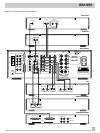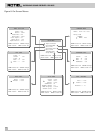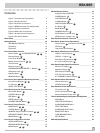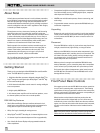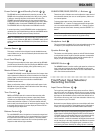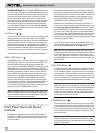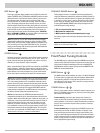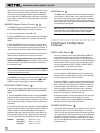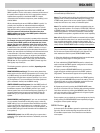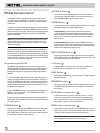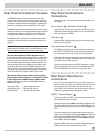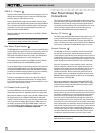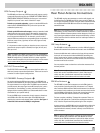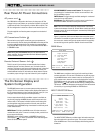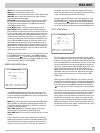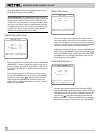
RSX-965
15
The following configuration instructions refer to LARGE and
SMALL speakers. The size refers more to the bass performance of
the speaker than its physical size. A full-range speaker that has
extended bass response is considered LARGE. A compact
minispeaker with limited bass response or power handling is con-
sidered SMALL.
While understanding the terms LARGE and SMALL is useful, it is
probably more important to understand what these different
speaker types mean in terms of
system
performance. This will
help determine how you should configure your system. In a nut-
shell, the system will redirect bass information away from
SMALL speakers and send it to the LARGE speakers and/or the
SUBWOOFER in your system.
Things become a little more complex in systems with a subwoofer.
For example, the system will generally not redirect bass informa-
tion away from a LARGE speaker to the subwoofer and, in fact,
may not even give you a subwoofer option if you tell it you have
LARGE speakers. Thus, the decision you need to make when con-
fronted with a choice of LARGE or SMALL is whether or not you
want the particular speaker to play the deep bass information or
whether your would prefer that the deep bass information be sent
to the subwoofer. If you have invested in a robust, earthquake-
ready subwoofer for your system, you might very well decide to
send all of the bass to it, regardless of how capable the other
speakers in the system may be. In this case, you would tell the
RSX-965 that all of your speakers are SMALL, without regard to
how big they may actually be.
The following speaker options are available, depending on the
surround mode:
FRONT SPEAKERS (small/large): This menu setting determines
what kind of main front left and right speakers you are using. Use
the LARGE setting if your main left and right speakers are full
range designs with good bass response capability. If you are us-
ing minispeakers or if you want the bass from these speakers to
go to a subwoofer instead, use the SMALL setting.
CENTER SPEAKER (small/large/none): Use the LARGE position if
your system’s center channel speaker is capable of full-range, ex-
tended bass response. Use the SMALL position if your center
channel speaker has more limited low frequency capability, or if
you prefer that the bass be sent to the subwoofer. Select the
NONE setting if your system does not have a center channel
speaker.
REAR SPEAKERS (small/large/none): If your rear surround speak-
ers are capable of sustained low frequency output , select the
LARGE setting. If your rear speakers have limited bass capability
or if you would prefer that the bass go to a subwoofer, use the
SMALL setting. If your system has no rear surround speakers, se-
lect the NONE setting (surround information will be added to the
front speakers).
SUBWOOFER (yes/no): Use the YES setting if your system has a
subwoofer. If your system does not have a subwoofer, select the
NO setting.
Note 1: Speaker configuration must be repeated for each different
surround mode you intend to use.
Note 2: The available options during the configuration procedure
depend on the current surround mode setting. For example, in 3-
STEREO mode, there will be no rear speaker option. In STEREO
mode, there will be no rear, center, or subwoofer option.
Note 3: The available subwoofer options may depend on the set-
tings for the other speakers. For example, in PRO LOGIC, DSP, and
3-STEREO modes, you cannot activate a subwoofer if you select
LARGE front speakers. To activate a subwoofer in these modes,
select SMALL front speakers, regardless of their actual capability.
Note 4: Dolby Digital and DTS modes are automatically activated
based on software codes; there is no manual mode setting. There-
fore, to configure the speaker settings for these modes, play a
Dolby Digital or DTS digital recording to activate these modes and
then press the SPEAKER MODE button to configure the speakers.
There are two ways to configure your speaker system. One is the
On-Screen menu system (described later in this manual). The
other method uses the front panel SPEAKER MODE button:
1. Select the desired surround mode with the front panel buttons
or by playing a Dolby Digital or DTS digital source.
2. Press and hold the SPEAKER MODE button for at least 2 sec-
onds to activate the FRONT speaker configuration. An indicator
will appear in the front panel display.
3. Quickly press the SPEAKER MODE button in succession to
toggle through the available options for the FRONT speakers
(large/small). The selection will appear on front panel display.
4. When the correct size configuration for your FRONT speakers
appears, press the MEMORY button to store the setting. This will
automatically take you to the configuration options for the next
type of speaker, for example, the CENTER speaker.
5. Repeat steps 3 and 4, pressing the SPEAKER MODE button
quickly in succession until you reach the desired setting and then
confirm the selection by pressing the MEMORY button. Continue
until you have set the proper configuration for all types of speak-
ers in the current surround mode.
Once complete, you can check the current settings at any time by
briefly pushing the SPEAKER MODE button repeatedly to toggle
through the various speaker settings.
MENU Button
12
52
Activates the On-Screen Menu system for system setup and con-
figuration. See the section detailing the operation of the On-
Screen Menu system below. Press the button to activate the
menu system.



